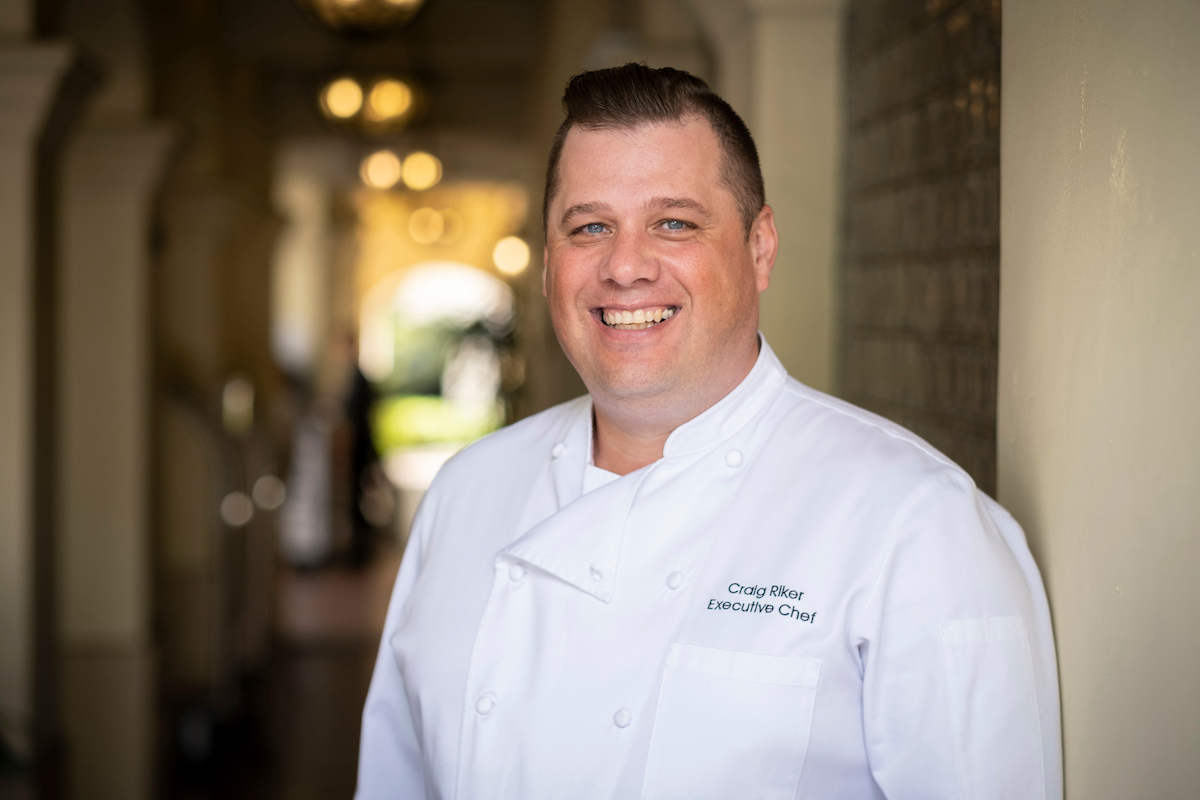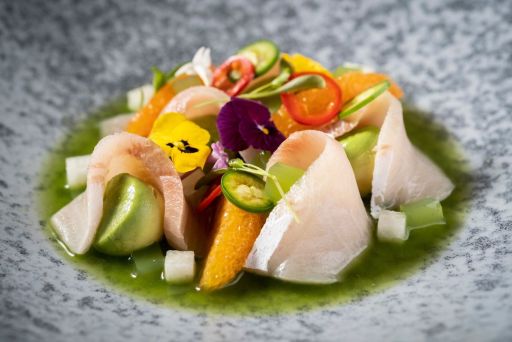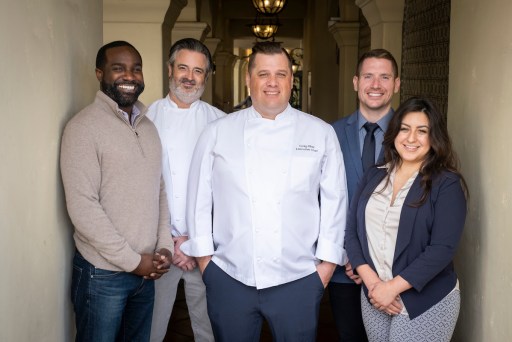Finch & Fork’s Real Rock Star Chef
Musician Craig Riker Running Kitchen in Canary Hotel

There was much to like early on in our dinner at the revised Finch & Fork a few weeks ago: the truffled funk and Espelette-enhanced smokiness on the sweet white potato soup; the black garlic Caesar, “perfectly dressed,” according to my Caesar-addicted wife; the warm crunch of pork belly on a chilled deviled egg; the super-fresh tuna poke with lavash chips and delicate hamachi crudo in cucumber aguachile.

But the head-turner came during entree time, and it wasn’t my pork chop topped with pecan and fried apples, nor my wife’s slab of king salmon. Sprinkled atop our lemony, Calabrian-chili-flecked broccolini side dish was an unfamiliar herb — tiny spindles of green lace with a flavor somewhere between tarragon, cilantro, and citrus.
As someone whose job is to relay what food and wine tastes like in accurate while approachable ways, I’m constantly on the hunt for new flavors and aromas. But after half a lifetime eating all sorts of foods in all sorts of places, finding a truly unique taste or smell is rather rare, especially when so much of my exploration in recent years has been confined to the Central Coast.
“What is that?” I asked my wife, and then the waiter, who relayed the query to the chef. “Tangerine gem marigold” was the answer, grown by a microgreen specialist called Plate Linguistics in Piru, where they also sell dainty shoots of garbanzo, amaranth, “popcorn,” and various radish and mustard varieties.
“I like to throw those little surprises in there, those things I haven’t seen before but taste delicious,” explained Chef Craig Riker, who reopened this restaurant on the bottom floor of the Kimpton Canary Hotel in May. “That’s what I’m searching for: unique things that are interesting and keep people coming back to see what’s next.”
Punk-Rock Roots
Riker’s own roots might be most surprising of all. Prior to embarking on the chef’s life, he was a professional rock ’n’ roller, most recently playing bass in Deadsy. During that industrial metal band’s nationwide tours, Riker ate widely and well, walking through the restaurant doors that opened for Deadsy’s well-connected founder, Elijah Blue Allman, the son of Cher and Gregg Allman.
“That’s where my style came from,” he explained. “I could be in New Orleans or could be in San Francisco or could be in New York — just trying different things on tour, that’s where I started really enjoying the finer foods.”
As one of five siblings growing up in Pensacola, Florida, Riker’s earliest eating revolved around whatever his working mom could get on the table quick enough, but it tended toward comfort food. “My grandmother would cook a lot of Southern-style dishes,” he said. “Fried chickens, okra, collard greens, black-eyed peas, that sort of thing.”

Pensacola’s “thriving music scene” is what captured his attention then. “We had every band that was cool come through there,” said Riker, who got to see bands like Soundgarden and Primus in small clubs before they blew up, as bigger acts like Van Halen, Depeche Mode, and Michael Jackson hit the city’s larger venues to prepare for big tours. Riker was playing in punk bands by age 13, explaining, “I opened up for Green Day before Dookie came out.”
He worked in restaurants during high school, making salads for pocket money, and then signed onto a record label with his skate-punk band Blount at age 19. Upon coming to California, Riker briefly joined the Simi Valley punk band Strung Out before falling in with the Deadsy crew in 1998.
The road-tripping rock-star shine wore off about four years later. “At one point, it lost some of the fun,” he said. “I just wanted to try something different, so I enrolled in Cordon Bleu in Pasadena.”
Sign up to get Matt Kettmann’s Full Belly Files, which serves up multiple courses of food & drink coverage every Friday, going off-menu from our regularly published content to deliver tasty nuggets of restaurant, recipe, and refreshment wisdom to your inbox
A fan of cooking shows since watching Julia Child, Jacques Pépin, and Martin Yan (Can Cook) in his youth, Riker was fired up by that initial Food Network zeitgeist — “the ‘bam!’ stage” of Emeril Lagasse that turned so many of us onto performative cooking in that late 1990s era. At Cordon Bleu, he came under the tutelage of Evan Funke, who’d soon rise to celebrity chef status himself. After working for a year at Three Forks Chip House in Claremont, Riker went to work for Funke at Rustic Canyon in Santa Monica, developing close relationships in that city’s massive farmers’ market.
In 2010, Riker’s wife began attending UCSB, so he left his gig at the Montage Beverly Hills to work at Miro in Goleta’s Bacara Resort. Next, aside from six months at Mastro’s in Malibu and a year at Santa Barbara’s reopened Belmond El Encanto, Riker developed menus for Nordstrom’s nationwide collection of nearly 200 cafés until 2017.
That year, he embarked on his most ambitious project yet: creating a completely plant-based menu to launch Oliver’s in Montecito, the Coast Village Road restaurant owned by clean-eating cellular mogul Craig McCaw. Watching the shift to vegetarian cuisine at places like Noma in Copenhagen and Eleven Madison Park in New York City, Riker was ready to take on that challenge, explaining, “It was the right choice for me at the right time.”
Back to the Hotel
Oliver’s quickly caught a committed clientele, who continue to enjoy many of Riker’s original menu concepts today. But the pandemic pause set the chef looking for a new challenge, which arose with the chance to reenvision Finch & Fork.
“I’m able to do whatever I want creatively,” said Riker, who was ready to cook meat again. “That’s made it really appealing.”
The May reopening coincided with a complete refresh of the restaurant’s interior as well. Gone are the wood beams, brown leathers, and Andalusian-adjacent themes of the original decor, which cast somewhat of a big-city-hotel-meets-cigar-lounge vibe. (I liked that, personally.) Now, it’s all soft tones, light wood, and bright light, more bistro spa than steakhouse.
The sunny atmosphere certainly matches much of Riker’s cuisine, particularly the many salads and fresh seafood apps and entrees. (“This is the best poke I’ve ever had, and that includes Hawai‘i,” was my wife’s endorsement.) But there’s plenty of heavier options on the menu too, including my pork chop, a short rib pappardelle, buttermilk fried chicken, and a New York strip.

“That’s my mindset: We can be very inclusive of all different types of diners,” said Riker, who sees these early days, when staffing remains an issue for all restaurants, as just a glimpse of what’s to come. “Right now, we’re at the ground floor. Our aim is to evolve and take it from there in different ways without getting overly stuffy and white-tablecloth-y. We don’t want to be the place where you only come on special occasions. We’d love to have people come all the time. Come sit at the bar and have tuna poke, or come celebrate your anniversary and go all out.”
Riker plans to make Finch & Fork a mandatory check-in for those seeking the frontiers of taste as well. “We will focus on familiar flavors, but do them in my version,” said Riker. “And every once in a while, I’ll throw something a little bit more for culinarians.” Just like that tangerine gem marigold, which will keep me coming back.
In the Kimpton Canary Hotel, 31 W. Carrillo St.; (805) 884-0300; finchandforkrestaurant.com
Support the Santa Barbara Independent through a long-term or a single contribution.




You must be logged in to post a comment.